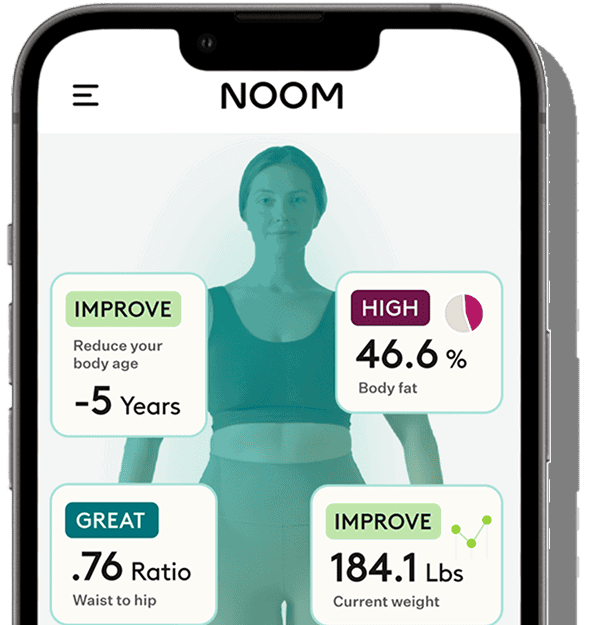What you’ll learn:
- Weight gain and shifting fat storage around the belly are common during menopause, driven by changes in hormones, metabolism, and aging.
- Extra belly fat at this stage isn’t just about appearance; it’s linked to higher risks of heart disease, diabetes, dementia, and certain cancers.
- You can take charge with science-backed strategies—like focusing on nutrition, exercise, sleep, and stress management—with added support from HRT or GLP-1 medications when needed.
If you are in your late 40s or early 50s and you feel like you’re gaining weight without changing your diet or exercise level, you’re not alone. Research shows that many people gain five pounds during menopause, some more, and many notice more fat around their abdomen, even if they don’t gain weight. This so-called “menopause belly” can be tough to get rid of. And this extra belly fat isn’t just about how you look in the mirror.
Excess belly fat, also known as visceral fat, can be associated with an increased risk for cardiovascular disease, dementia, diabetes, and certain types of cancer. That’s why addressing weight management during menopause is so important.
The good news is that there are ways to manage these changes. Though weight gain can have many causes, hormonal changes, like fluctuating estrogen and progesterone levels during this period, can cause fat to shift to your belly. Focusing on science-backed strategies is key, like eating a well-balanced, nutrient-dense diet, exercising regularly, reducing stress, and improving sleep. Hormone replacement therapy (HRT) and weight loss medication can also help some people.
What is menopause belly?
The term “menopause belly” is not a medical diagnosis. Instead, it’s a common description for the weight gain and redistribution of fat that many experience during and after menopause. This redistribution can be particularly frustrating. Some people notice that while their weight remains stable, their waistline expands and clothes feel tighter around the middle. This is partially a result of hormonal changes that influence where your body stores fat, although lifestyle and genetics can also play a significant role.
The changes that lead to menopause belly fat begin long before your periods stop completely. They occur across the stages of menopause:
- Perimenopause: This is the transitional phase leading up to menopause, and it can begin in a woman’s late 30s or early 40s. During this time, estrogen and progesterone levels start to fluctuate unpredictably. This hormonal instability, combined with the body composition shifts of aging, can cause weight gain and the accumulation of fat around the midsection.
- Menopause: Menopause is officially diagnosed after you have gone 12 consecutive months without a menstrual period. The average age for menopause in the U.S. is 51. At this point, the ovaries have stopped producing significant amounts of estrogen, and these lower levels are directly linked to a shift in fat storage.
- Postmenopause: This is the stage that begins after menopause is confirmed and lasts for the rest of your life. The hormonal changes are permanent, and the trend of accumulating belly fat can continue. This is why a proactive strategy is essential for long-term health and well-being.
“Most women are caught off guard because the metabolic groundwork for menopause belly is laid years before their periods actually stop. The subtle weight gain during perimenopause is the first sign, making that transitional stage the most critical time to intervene,” says Dr. Karen Mann, MD, OB-GYN and Noom Medical Director.
The science behind menopause belly: Hormones and metabolism
If you’re dealing with menopause weight gain, or stubborn belly fat, the first step is understanding what’s really going on in your body. It’s not about willpower or making the “wrong” food choices—it’s the result of shifting hormones, a slowing metabolism, and the natural changes that come with age.
What this means:
- It’s not a quick-fix situation. Lasting changes usually require shifts in nutrition, exercise, stress management, and sleep.
- Because hormones play a central role, some people may find that lifestyle changes alone aren’t enough. In certain cases, hormone replacement therapy (HRT) can help address some of the root hormonal imbalances.
The hormonal connection: Estrogen, progesterone, and testosterone
Three key hormones are at the center of the menopause belly fat puzzle:
- Estrogen: Before menopause, estrogen tends to direct fat to the hips and thighs. As levels fall, the body shifts toward storing more fat around the belly. Studies show this redistribution comes with a higher risk for heart disease and metabolic changes.
- Progesterone: Progesterone drops too, and while it doesn’t get as much attention as estrogen, its decline still matters. Falling progesterone, combined with low estrogen and a changing ratio of androgens, can add up to more overall fat gain during the menopause transition. Some women also notice bloating or fluid shifts when levels dip.
- Testosterone: Women make testosterone as well, and levels gradually decline with age. Lower testosterone in postmenopausal women is tied to loss of lean muscle, which makes it harder to keep metabolism humming. At the same time, when estrogen falls faster than testosterone, the result can be a kind of relative androgen excess that’s been linked to more belly fat and insulin resistance.
Other hormones that can lead to an increase in belly fat during menopause
While falling estrogen plays a big role in why fat storage shifts during menopause, it’s not the only factor. Other hormones are involved, too, and together they create a tricky metabolic environment that makes belly fat more likely to stick around. Knowing how these hormones work gives you a clearer picture of why weight management during this stage takes more than a one-size-fits-all solution.
- Cortisol: Often called the stress hormone, cortisol can drive cravings for sugary, calorie-dense foods and signal your body to store more belly fat. During menopause, higher cortisol can be even more of a challenge, since this stage of life often comes with sleep disruptions, mood shifts, and other stressors that naturally push cortisol levels up.
- Insulin resistance: With age and especially with increased abdominal fat, your cells can become less responsive to insulin, a condition known as insulin resistance. This leads to higher blood sugar levels and can trigger your body to store more fat, particularly around the belly. This cycle is a major concern for postmenopausal health and can also cause weight gain during and after menopause.
The combination of these hormonal shifts, coupled with the natural metabolic slowdown and body composition changes that occur with age, can lead to the accumulation of abdominal fat.
How to know if your belly fat is a health risk
Belly fat isn’t just about jeans fitting snug; it can signal what’s happening inside your body. The kind you can see (subcutaneous fat) is less concerning, but the deeper kind (visceral fat) wraps around your organs and raises your risk for heart disease, diabetes, and more. During menopause, shifting hormones make this type of fat more likely. The good news? Simple at-home measurements can help you spot if your belly fat is a health risk.
Visceral fat vs. subcutaneous fat
There are two main types of abdominal fat, but one carries much higher health risks:
- Subcutaneous fat: This is the soft, pinchable fat just under the skin. While it can contribute to being overweight, it is generally less metabolically harmful than deeper fat stores.
- Visceral fat: This is the deeper fat that surrounds your internal organs. It is metabolically active, releasing inflammatory compounds and hormones that increase the risk of cardiovascular disease, type 2 diabetes, and insulin resistance, and even certain cancers.
Visceral fat is the primary concern during and after menopause, as hormonal shifts favor fat storage around the midsection.
Key measurements for understanding your risk
Since you can’t see or pinch visceral fat, simple body measurements are the best way to estimate risk:
- Waist circumference: A waist size greater than 35 inches (≈ 89 cm) in women is associated with a significantly higher risk of hypertension, type 2 diabetes, and cardiovascular disease. To measure, stand upright, place a flexible tape measure around your waist just above the belly button, and measure after gently exhaling.
- Waist-to-hip ratio (WHR): A WHR of ≥ 0.85 in women is linked to abdominal obesity and greater risk of cardiometabolic disease. To measure, record your waist circumference as above, then measure around the widest part of your hips. Divide the waist by the hip measurement to calculate the ratio.
- Waist-to-height ratio (WHtR): A WHtR of ≥ 0.5 (waist more than half your height) strongly predicts visceral fat and risk of metabolic disease, often more accurately than BMI. To measure, divide your waist circumference by your height, making sure both are in the same units (inches or cm).
You can also use Noom Body Scan through the app to get a more detailed look at your body composition and fat distribution over time. Understanding these numbers is the first step toward creating a personalized, data-driven plan to lose belly fat after menopause and improve your overall health.
How to reduce belly fat during menopause with lifestyle changes
While hormonal shifts during menopause play a significant role in the accumulation of belly fat, you have powerful tools at your disposal to counteract these changes. It’s all about learning to work with your body in this new phase of life. A holistic approach that integrates four key lifestyle pillars can make a profound difference. They are:
- What you eat
- How you move
- The quality of your sleep
- How you manage stress
These elements are interconnected, and focusing on them together creates a synergistic effect that not just helps reduce belly fat but also boosts your overall health, energy, and well-being.
What to eat
When it comes to reducing menopausal belly fat and losing weight, what you eat is one of the most important aspects. Creating a balanced, sustainable approach that nourishes your body while helping you manage weight and wellness in the long term. To reduce belly fat, maintain a healthy weight, and support your health during and after menopause, focus on these tips:
Get adequate protein
Protein is one of the strongest tools for preventing belly fat gain during menopause. As estrogen falls, women commonly lose lean mass and move less, which can lower daily calorie needs. Sufficient protein combined with strength training helps protect metabolism.
Studies estimate that declining estrogen reduces metabolism by 250 to 300 calories per day, making muscle preservation essential. Aim for 1 to 1.2 grams of protein per kilogram (that’s about 70–85 g/day for a 150-pound person).
Protein helps:
- Shrink belly fat: Adequate protein helps prevent the loss of lean mass, and provides the building blocks needed with resistance training required to maintain muscle mass, which otherwise lowers metabolism and accelerates visceral fat gain.
- Boost satiety: Protein-rich foods help you stay full, helping you reduce calories naturally.
- Smart picks: Chicken, fish, eggs, dairy, beans, lentils, tofu, nuts, and seeds..
Choose fiber-rich, low-GI carbohydrates
Not all carbs work the same for your body, especially during menopause. Focusing on high-fiber options can help you maintain or lose weight by:
- Stabilizing blood sugar: Carbs with a low glycemic index and load release energy more gradually, avoiding sharp insulin spikes.
- Helping you feel full: High-fiber foods keep you satisfied longer and support blood sugar control.
- Smart picks: Whole grains, beans, lentils, high-fiber vegetables and fruits, nuts, and seeds.
💡Tip: Pair these with protein-rich foods to enhance satiety and steadier energy levels.
Load up on colorful produce
Colorful fruits and vegetables can help manage weight and support hormone balance during menopause by:
- Helping reduce belly fat: Diets rich in fruits and vegetables are linked to lower visceral fat in menopausal women.
- Fighting inflammation: A varied mix of produce provides antioxidants and phytochemicals that help reduce oxidative stress and inflammation, both of which are tied to hormonal changes.
- Boosting nutrient intake: These foods deliver essential vitamins, minerals, and fiber that protect metabolic and cardiovascular health.
- Smart picks: Leafy greens, cruciferous veggies (broccoli, cauliflower, cabbage), berries, apples, citrus, peppers, and carrots.
💡 Tip: Aim for at least five servings per day: 3 to 4 servings of vegetables and 1 to 2 servings of fruit
Incorporate healthy fats
Healthy fats are critical during menopause for hormone health, satiety, and cardiovascular protection. According to a review on nutrition in menopause, dietary fat quality is more important than total fat amount. Here’s how the right fats help:
- Supporting hormones: Fats are essential for hormone regulation, which is especially important when estrogen levels decline.
- Curbing cravings: Adding healthy fats helps promote satiety, making it easier to manage appetite and avoid overeating.
- Protecting the heart: The review recommends replacing saturated fats with polyunsaturated fats, especially omega-3 fatty acids, to improve cholesterol and reduce cardiovascular risk.
- Smart picks: Avocados, nuts, seeds, olive oil, and fatty fish like salmon, sardines, or trout.
💡 Tip: Keep saturated fat below 10% of daily calories and avoid processed foods high in trans fats.
Support bone and belly health with calcium and vitamin D
Beyond bone protection, calcium and vitamin D help regulate fat storage and metabolism. They are key preventive nutrients in menopause. You need about 1,000 to 1,200 mg/day of calcium and about 2000 IU/day of vitamin D in low-sun months. Calcium and vitamin D help to:
- Lower belly fat risk: Estrogen decline promotes belly fat accumulation; vitamin D deficiency worsens insulin resistance and fat storage.
- Calcium connection: Adequate calcium, especially from dairy, supports healthier body composition alongside bone strength.
- Smart picks: Low-fat dairy, fortified plant milks, nuts, seeds, soft-boned fish (like sardines).
💡 Tip: Supplements should only be used if a deficiency is diagnosed.
“While calories do play a part in weight management, the key to managing menopausal belly fat is to eat more of the right things. More protein to fuel metabolism, more fiber to stay full, and more nutrient-dense foods to fight inflammation. It’s about nourishment, not deprivation,” says Dr. Mann.
Foods to limit to reduce menopause belly fat
Just as important as what you eat is what you limit. To reduce belly fat during menopause, consider reducing your intake of:
- Ultra-processed foods: These are often high in calories, unhealthy fats, sugar, and sodium, and they contribute to inflammation and weight gain. But not all processed foods are bad. The trick is to learn how to choose processed foods wisely to find the balance between convenience and health.
- Added sugars and refined carbs: Foods like candy, sodas, white bread, and pastries cause rapid spikes in blood sugar and insulin, which can increase fat storage around the abdomen.
- Excess alcohol: Alcohol is high in empty calories and can disrupt sleep and hormone balance, both of which contribute to belly fat.
The most effective exercises to reduce menopause belly fat
You can’t spot reduce belly fat. To reduce fat, you need to focus on improving your diet and moving more. A combination of low-impact, enjoyable cardio and strength training is particularly effective for people managing menopause weight gain.
Build strength with resistance training
Strength training is one of the most effective ways to counter menopause-related weight gain, belly fat, and metabolic decline. Both a review on resistance training and a study on bone density highlight its benefits:
- Boosts metabolism: Muscle tissue is more metabolically active than fat, so adding lean mass through resistance training helps offset the age-related metabolic slowdown.
- Reduces belly fat: Strength training specifically helps reduce visceral adiposity, the type of belly fat that increases during menopause.
- Improves bone health: Menopause accelerates bone loss, raising osteoporosis risk. Resistance training stimulates bone remodeling and density.
- Enhances insulin sensitivity: Regular resistance exercise improves the body’s response to insulin, helping regulate blood sugar and lower type 2 diabetes risk.
💡 Tip: Aim for 2–3 sessions per week using free weights, resistance bands, or bodyweight moves, focusing on major muscle groups.
Incorporate heart-healthy cardio
Cardio really earns its spot in a menopause workout plan. Research shows it helps trim body fat, shrink waist size, and improve overall metabolic health. Large studies link higher volumes of physical activity to better weight control and lower fat mass in midlife and postmenopausal women. Research also shows that aerobic training enhances insulin sensitivity and reduces cardiometabolic risks. Here’s what to keep in mind:
- Choose something you can do consistently over something strenuous: In one study, women in the postmenopause period who walked at a moderate pace for 12 weeks lowered their BMI, body fat percentage, and waist circumference.
- Make sure you get in enough: Getting in at least 150 minutes of aerobic exercise per week significantly reduces deep belly (visceral) fat. Choose brisk walking, cycling, or swimming. Including higher-intensity intervals may provide additional belly-fat benefits.
When it comes to cardio, the key is to find something you enjoy. Noom supports “joyful movement,” encouraging you to find activities that make you feel good and that you’ll look forward to. For more ideas on how to incorporate movement into your routine, check out our article on walking for weight loss.
Lifestyle adjustments: Managing stress and sleep
When it comes to tackling menopause belly fat, diet and exercise are only half the puzzle. Your lifestyle—specifically how you manage stress and sleep—plays a \powerful role in regulating the hormones that control fat storage. As your body’s estrogen levels decline, cortisol levels can increase, triggering a cascade of metabolic changes.
- Stress management: High cortisol levels can increase cravings and also signal your body to store fat in the abdominal area. Finding healthy ways to manage stress is important. Actionable tips include practicing mindfulness, deep breathing exercises, or yoga. The Noom app offers psychology-based lessons and guided meditations designed to help you tackle these challenges and build a more resilient mindset.
- Sleep hygiene: Sleep disruption is a common menopause symptom and a major contributor to weight gain. A lack of sleep raises ghrelin (the hunger hormone) and lowers leptin (the fullness hormone), making you feel hungrier and less satisfied. Aim for 7 to 9 hours of quality sleep per night and create a relaxing bedtime routine to support better sleep hygiene.
For more insights, read our article on how sleep affects weight loss.
When and what you might need to supplement during and after menopause
While a balanced diet is the foundation, supplements can be a helpful addition to support specific nutrient needs during and after menopause. This is especially important for bone health as estrogen levels drop.
- Calcium and vitamin D: These are essential for preventing bone density loss and osteoporosis. The National Institutes of Health (NIH) recommends a daily intake of 1,200 mg of calcium and 600 IU of vitamin D for women over 50.
- Magnesium: This mineral is important for bone health and may also help reduce menopausal hot flashes, although more research is needed.
- Omega-3 fatty acids: Found in fatty fish and some nuts and seeds, omega-3s may help with night sweats in postmenopausal women.
For more information on supplements, check out our article on the best supplements for a healthy diet.
When to see a doctor for weight gain and belly fat during menopause
When diet and lifestyle changes don’t seem to make much of a change in your menopausal belly fat, it might be time to discuss medical options with your doctor. Addressing the underlying hormonal shifts can be a game-changer, and one of the most common treatments for managing menopause is hormone replacement therapy (HRT).
HRT can play a role in managing body composition. Here, we’ll explore how HRT can help shift fat distribution, the different types available, and its official status as a weight management tool.
Does HRT help you lose menopause belly fat?
HRT replaces the estrogen (often in coordination with progesterone) that your body stops making during menopause. While HRT is a common and effective treatment for many menopause symptoms, its relationship with belly fat is complex. The FDA hasn’t approved HRT as a treatment for weight loss or to prevent weight gain. Its effect on body composition is often considered a secondary benefit, not the primary reason for its prescription.
Replacing estrogen can help improve body composition in three key ways:
- It can help with fat distribution: HRT can help prevent the redistribution of fat to the abdomen. While it may not necessarily cause significant weight loss, it can help maintain a healthier body composition.
- It may reduce stress and improve sleep: By alleviating severe menopause symptoms like hot flashes and night sweats, HRT can help improve sleep quality and reduce stress, thereby indirectly helping to regulate cortisol levels and reduce cortisol belly.
“We have some evidence that HRT can help with fat distribution, and relief of bothersome menopausal symptoms helps people follow through with lifestyle changes that help with weight management, says Dr. Mann.
The type you get depends on whether you have a uterus:
- Estrogen-only therapy: For women without a uterus.
- Combination therapy: Estrogen plus progestin for women with a uterus to protect the uterine lining.
While HRT is not without risks, recent analysis suggests that for many healthy women, the initial concerns from older studies were likely overstated, especially when therapy is started within 10 years of menopause. Potential risks can include blood clots and certain types of cancer, which vary depending on the type of HRT, the dose, and individual health factors. This makes it a highly personal decision that requires a thorough discussion about your health history and goals.
HRT is available in various forms to suit different needs and preferences, including:
- Pills
- Skin patches
- Gels and creams
- Vaginal rings
The best approach is to discuss your options with a healthcare provider who can help you weigh the pros and cons. You can assess your needs and get expert medical guidance through programs like Noom + HRTRx.
GLP-1s and weight loss during menopause
It can be frustrating when you’re doing everything right with diet and exercise, but the scale won’t budge. When lifestyle changes aren’t enough to overcome the hormonal shifts affecting your metabolism, medical treatments can be an option to discuss with your doctor.
GLP-1 receptor agonists like Wegovy® (semaglutide) and Zepbound® (tirzepatide) can be helpful for people who meet certain criteria and want to lose weight during menopause. GLP-1s help manage metabolic changes by:
- Reducing hunger and quieting “food noise”: GLP-1s work on the same receptors in your brain that control hunger. This helps quiet intrusive thoughts about food and makes you feel satisfied and full with smaller portions.
- Improving how your body handles sugar. Menopause can throw your blood sugar out of whack and lead to insulin resistance, making it easier to store fat. GLP-1s help your body use its own insulin more efficiently, promoting stable blood sugar and reducing the hormonal drive to store fat.
- Helping you feel fuller, longer. These medications also slow down how quickly your stomach empties after a meal. This natural effect means you feel full for a longer period, making it easier to manage your calorie intake without feeling deprived.
These medications work with your body to overcome the metabolic shifts of menopause, making it easier for your healthy habits to pay off. If you’re wondering if this type of medical support is right for you, you can explore your eligibility through Noom Med and see what a prescription for Zepbound or Wegovy could do for you.
Combining HRT and GLP-1s can reduce weight and belly fat
GLP-1 medications can help people lose weight, but some evidence says they may work even better when paired with HRT. How?
- HRT helps address the hormonal changes of menopause by reducing abdominal fat gain, redistributing fat, and supporting muscle maintenance.
- GLP-1 medications focus on the metabolic side—lowering appetite, improving blood sugar, and slowing digestion to support steady weight loss.
As Dr. Mann explained in her interview with Vogue on the subject, “HRT helps correct the hormonal shifts of menopause, while GLP-1s tackle the appetite and metabolism changes that make weight gain so common. The two approaches complement each other, creating a stronger foundation for weight management in midlife.”
Can supplements help reduce menopause belly?
The supplement aisle is crowded with products claiming to target menopause belly fat. The reality? Most aren’t backed by strong science, and unlike prescription medications, supplements don’t go through strict clinical trials or FDA review before hitting the market.
A few have been studied in postmenopausal women, while others show promise only in broader populations. But the most reliable way to manage weight and belly fat during menopause is still through a foundation of nutrition, exercise, sleep, and stress management. Supplements, if used, should be considered add-ons, not cures, and always discussed with your healthcare provider.
Here’s what the evidence shows:
| Supplement | What the research shows | Verdict |
|---|---|---|
| Creatine Monohydrate | In postmenopausal women, creatine combined with resistance training helped build lean muscle and preserve bone density. | Best supported for body composition and metabolism — but only if paired with strength training. |
| Probiotics | Reviews suggest probiotics may support gut health and reduce cardiovascular risk markers in menopause, though no direct link to weight loss. | Good for digestion/bloating; not a proven weight strategy. |
| Phytoestrogens (soy isoflavones) | Some studies suggest soy protein may help with fat distribution, while others show no change in weight or composition. The Menopause Society does not recommend soy for weight loss. | Mixed evidence; food-based soy is fine, supplements aren’t reliable. |
| Green tea extract (EGCG) | A trial showed metabolic improvements, but another found no changes in belly fat or bone density. | May give a mild metabolic bump; not strong for weight. |
| Berberine | Berberine improves insulin sensitivity and lowers blood sugar in adults; it hasn’t been studied for menopause directly. | May help if insulin resistance is an issue; unproven for menopause belly fat. |
| Ashwagandha | Trials show ashwagandha helps with stress, cortisol, and certain menopause symptoms, but none measured fat loss. | Helpful for stress and sleep; not evidence-based for weight. |
Supplements to skip
| Supplement | What the research shows | Verdict |
|---|---|---|
| Black cohosh | Studied mainly for hot flashes. No effect on weight. Linked to rare but serious liver injury | Not effective for weight; carries safety risks. |
| Garcinia cambogia | A large RCT found no meaningful weight loss vs placebo. | Ineffective for fat loss. |
| DHEA / 7-Keto-DHEA | Trials in older adults show no improvements in body composition. Reviews warn of hormonal risks. | No reliable benefit; potential hormone-related harm. |
Frequently asked questions about menopause belly fat
Is menopause belly bloat different from menopause belly fat?
Yes, they are different. Menopause belly bloat is often temporary, caused by a buildup of gas from dietary changes, hormonal fluctuations, or digestive issues. Menopause belly fat is a more permanent accumulation of fat tissue, especially visceral fat, that occurs due to hormonal changes over time. While bloating can contribute to a larger-looking midsection, it’s not the same as a long-term increase in fat.
Can I get rid of menopause belly without exercise?
While exercise is important for general health and weight management, it’s possible to lose weight through diet alone. However, combining a healthy diet with regular exercise, especially strength training, is the most effective and sustainable way to reduce belly fat.
How long does it take to lose menopause belly fat?
There’s no single answer, as it varies person to person. For some, changes can be seen in a few months. For others, it may take longer. The key is to be patient and focus on building sustainable, healthy habits rather than seeking quick fixes.
What are phytoestrogens, and can they help reduce menopause belly fat?
Phytoestrogens are compounds found in plants like soy, flaxseed, and chickpeas that can mimic the effects of estrogen in the body. They’ve been studied for their potential to help balance hormones and reduce menopause symptoms. Research shows they may offer modest benefits for hot flashes, bone health, and cognition, but the evidence is mixed and not strong enough to recommend them as a reliable treatment. For some women, they may help with certain symptoms like hot flashes, but they are not a solution for issues like hormonal belly fat.
The bottom line: Managing menopause belly fat takes a combined approach
While hormonal shifts make managing weight during menopause more challenging, you can take control with a strategy that combines a few different strategies.
Here is the bottom line on how to manage menopausal weight gain:
- Prioritize protein and fiber: Aim for 25-30 grams of protein with each meal to preserve muscle mass and stay full. A high-fiber diet from vegetables, legumes, and whole grains helps stabilize blood sugar and insulin levels, which can help reduce belly fat.
- Focus on strength training: Building and maintaining muscle is the most effective way to counteract the metabolic slowdown of menopause. Aim for at least two strength training sessions per week (lifting weights, using resistance bands, or bodyweight exercises). Complement this with consistent cardio like brisk walking, cycling, or swimming.
- Manage stress and prioritize sleep: Aim for 7-9 hours of quality sleep per night. Poor sleep raises cortisol, a stress hormone that directly signals your body to store belly fat. Incorporate stress-reducing practices like meditation, deep breathing, or yoga to keep cortisol levels in check.
- Consider hormone replacement therapy (HRT): While not a weight-loss drug, HRT can be a powerful tool for many women. Under a doctor’s guidance, it helps rebalance hormones to reduce the accumulation of visceral belly fat, preserve muscle, and improve sleep, making your diet and exercise efforts more effective. Check out Noom + HRTRx for more information on how to get started.
- Consider GLP-1 medications: For some women, diet and lifestyle changes alone aren’t enough to reduce stubborn weight gain. Medications like GLP-1 receptor agonists can be a useful tool, as they help regulate appetite and satiety hormones, making it easier to manage food intake and lose weight. See if you qualify for Noom Med and speak to your clinician about finding the right medication for you.
This holistic approach, addressing lifestyle habits, HRT, and medication, if needed, helps you manage your weight and may reduce your risk of chronic diseases. The right support can help you navigate this chapter of life with confidence.




 Noom Team
Noom Team
 Meaghan Cameron
Meaghan Cameron

